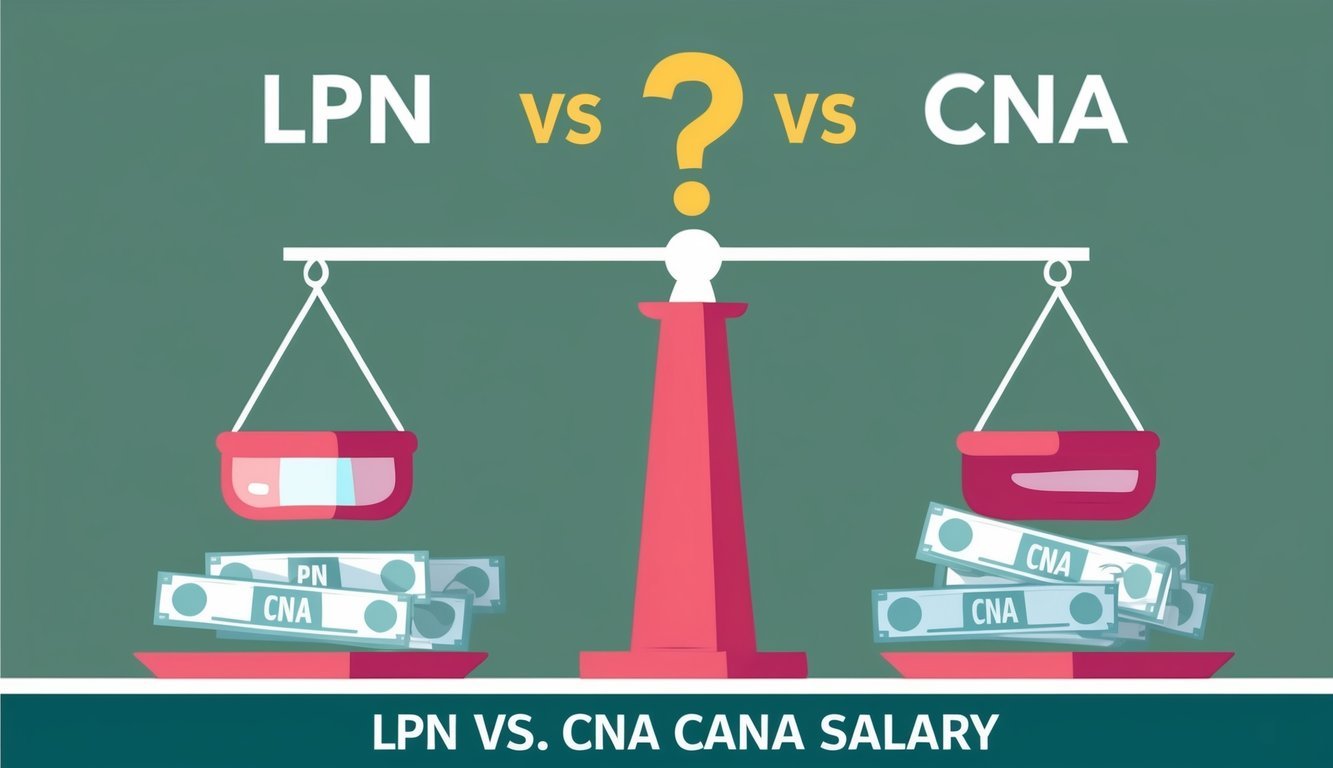The healthcare field offers many career paths, but understanding the differences in salaries between Licensed Practical Nurses (LPNs) and Certified Nursing Assistants (CNAs) can help you make an informed decision. LPNs generally earn a higher median annual salary of about $48,820, while CNAs average around $32,050. These salary differences reflect varying responsibilities, education requirements, and career advancement opportunities in the healthcare sector.
As you explore these roles, consider how each position fits your career goals.
LPNs often have more complex duties and require more education than CNAs, which can lead to higher pay and more responsibility.
Understanding the distinctions and potential financial outcomes of these professions is crucial as you plan your future in healthcare.
Key Takeaways
- LPNs typically earn more than CNAs due to their additional training and responsibilities.
- Educational requirements differ greatly, impacting job options and salary potential.
- Both positions offer unique opportunities for growth and advancement in the healthcare field.
Understanding the Roles

In the healthcare field, both Certified Nursing Assistants (CNAs) and Licensed Practical Nurses (LPNs) play vital roles in patient care.
Each position has specific responsibilities that contribute to the well-being of patients in various settings.
Role of a Certified Nursing Assistant (CNA)
As a CNA, you provide essential support to patients in daily activities.
Your tasks include assisting with Activities of Daily Living (ADLs) such as bathing, dressing, and feeding.
CNAs are often the first point of contact for patients, making your role crucial in maintaining their comfort and safety.
In addition to personal care, you monitor patients’ vital signs, report any changes in their condition, and ensure they stay comfortable.
This role typically requires certification, which involves completing a training program and passing an examination.
You may work in various settings, including nursing homes, assisted living, and home health care.
Role of a Licensed Practical Nurse (LPN)
If you are an LPN, you have a broader scope of practice compared to a CNA.
You provide basic patient care, administer medications, and assist with medical procedures under the supervision of registered nurses or doctors.
LPNs often work closely with patients, providing direct care and monitoring their health.
Your duties may involve assessing patient needs, developing care plans, and educating patients about their health.
Becoming an LPN requires more training than a CNA, including completing a practical nursing program and obtaining licensure.
LPNs work in a variety of healthcare settings, including nursing care facilities and hospitals, where teamwork and communication are essential for patient care.
Educational Paths
Understanding the educational paths for CNAs and LPNs is crucial for making an informed career choice.
Each role has distinct requirements that can impact your training, certification, and ultimately, your job opportunities.
CNA Education and Training
To become a Certified Nursing Assistant (CNA), you typically need to complete a CNA training program.
This program usually lasts between 4 to 12 weeks.
These programs are offered at community colleges, vocational schools, and some hospitals.
During your training, you will learn essential skills, including basic patient care and safety practices.
The curriculum often covers subjects such as:
- Anatomy and Physiology
- Infection Control
- Patient Rights
- Communication Skills
After completing the program, you must pass a certification exam to become a CNA.
Each state requires certification, often involving both a written test and a practical skills assessment.
The training is designed to prepare you for hands-on care, equipping you with the skills needed for daily patient interaction.
LPN Education and Training
To become a Licensed Practical Nurse (LPN), the path is longer and more involved. LPN training programs typically require 1 year of education.
These programs are offered through community colleges, vocational schools, and sometimes private nursing schools.
Your education will include coursework in vital topics such as:
- Pharmacology
- Nursing Fundamentals
- Medical-Surgical Nursing
- Maternal and Child Health
In addition to classroom learning, you will also engage in clinical practice to gain firsthand experience under supervision.
Upon completing the program, you will need to pass the NCLEX-PN (National Council Licensure Examination for Practical Nurses) to become licensed.
This exam tests your knowledge and ability to provide safe, effective nursing care.
The additional training and licensing requirements reflect the greater responsibilities of LPNs compared to CNAs.
Comparing Salaries
When evaluating the salaries for Certified Nursing Assistants (CNAs) and Licensed Practical Nurses (LPNs), it’s essential to understand the differences in their earnings and the factors that influence these numbers.
CNA Salary Overview
The salary for Certified Nursing Assistants can vary significantly based on experience and location.
As of recent data, the median annual salary for CNAs is around $38,200 according to the Bureau of Labor Statistics.
| Salary Type | Average Salary |
|---|---|
| Median Salary | $38,200 |
| Average Salary | $34,000 |
Some CNAs earn less than this amount, while those in high-demand areas or with specialized skills may earn more.
Additionally, entry-level positions typically start lower, while experienced CNAs can see increases based on performance and tenure.
LPN Salary Overview
Licensed Practical Nurses generally earn higher salaries than CNAs due to their expanded responsibilities and training.
The median annual salary for LPNs is approximately $48,820, as reported by various sources.
| Salary Type | Average Salary |
|---|---|
| Median Salary | $48,820 |
| Average Salary | $44,840 |
These figures can vary based on factors like geographic region and workplace settings.
For instance, LPNs working in hospitals tend to earn more compared to those in nursing homes or private care.
Factors Influencing Salary
Several factors can impact the earnings of CNAs and LPNs.
- Geographic Location: Salaries can differ widely between urban and rural areas. Cities with higher costs of living often pay more.
- Experience Level: More experienced professionals usually earn higher wages. Entry-level positions generally start lower.
- Workplace Type: Hospitals, clinics, and specialized care facilities may offer different pay rates.
The demand for healthcare professionals also influences salaries.
As the healthcare industry continues to grow, job outlooks for both CNAs and LPNs remain positive, suggesting opportunities for salary increases in the future.
For deeper insights into salary differences and career options, check out the detailed guide on LPN vs.
CNA salaries.
Career Development and Opportunities
In the healthcare field, both Certified Nursing Assistants (CNAs) and Licensed Practical Nurses (LPNs) have unique career pathways and opportunities for advancement.
Understanding the prospects in terms of job growth and education is crucial for making informed decisions about your career.
Career Paths for CNAs and LPNs
As a CNA, you primarily assist patients with daily tasks such as bathing, dressing, and feeding.
This role is often seen as an entry point into the nursing profession.
Many CNAs choose to advance their careers by pursuing LPN certification.
LPNs take on more responsibilities, including administering medications and conducting basic medical procedures.
To move further up the ladder, LPNs can become Registered Nurses (RNs) by completing further education and training.
Career Path Options:
| Position | Description |
|---|---|
| CNA | Entry-level, assisting with patient care. |
| LPN | Provides basic nursing care and can supervise CNAs. |
| RN | Requires a degree and offers the highest level of responsibility. |
Job Growth and Employment Outlook
The job market for nursing professionals is strong.
According to the U.S. Bureau of Labor Statistics, employment for CNAs is expected to grow by 8% from 2019 to 2029, reflecting a high demand for healthcare services.
LPNs are also in demand, with job growth projected at 9% during the same period.
Growth in these fields is driven by an aging population and the need for long-term care.
Job Outlook Summary:
- CNA Growth: 8%
- LPN Growth: 9%
This demand means that both CNAs and LPNs can find a variety of job opportunities in hospitals, nursing homes, and home healthcare settings.
Continued Education and Bridge Programs
Continued education is vital for career advancement.
As a CNA, you can opt for bridge programs that allow you to transition to LPN status.
These programs are typically short and focus on skill development and clinical training.
For LPNs, pursuing an RN degree opens up even more career possibilities.
Community colleges and universities often offer flexible programs tailored for working professionals.
You can enhance your qualifications through ongoing training and certification courses to specialize in areas like pediatrics, geriatrics, or critical care.
Programs to Consider:
- Bridge Programs: Transition from CNA to LPN.
- RN Programs: Advance from LPN to RN.
Investing in your education ensures you develop the skills needed for a successful nursing career.
Work Environment and Scope of Practice

The work environment and scope of practice are crucial factors that differentiate CNAs and LPNs.
Understanding these areas can help you choose the right career path based on your interests and career goals.
Typical Work Settings for CNAs and LPNs
Both CNAs and LPNs can be found in various healthcare settings, but the environments differ in responsibilities and level of care.
Here are some typical work settings for each:
| Position | Typical Work Settings |
|---|---|
| CNA | – Nursing and Residential Care Facilities |
| – Assisted Living Facilities | |
| – Home Healthcare Services | |
| – Hospitals (often in support roles) | |
| LPN | – Nursing Homes |
| – Hospitals | |
| – Home Healthcare Services | |
| – Doctor’s Offices |
CNAs often assist residents with daily living activities.
They may help with bathing, dressing, and feeding.
LPNs have a wider scope and can administer medications, perform wound care, and monitor patients under the supervision of RNs.
Scope of Practice Differences
The scope of practice for CNAs and LPNs varies significantly, impacting the level of care they provide.
Here’s a quick overview:
-
CNA Responsibilities:
- Assist with daily living activities
- Monitor vital signs
- Report observations to nursing staff
-
LPN Responsibilities:
- Provide basic nursing care and administer medications
- Collect samples for lab tests
- Perform wound care and monitor patients closely
While both roles support patient care, LPNs can take on more complex tasks.
They are part of a healthcare team and require more training and licensure than CNAs.
This distinction is key in deciding which path aligns with your career ambitions.
For more detailed information, you can visit LPN vs.
CNA: What’s The Difference? and LPN vs.
CNA Salary + Core Differences.
Frequently Asked Questions

This section answers common questions regarding the salary and roles of LPNs and CNAs, covering salary differences, hourly rates, job duties, and regional variations.
What is the average salary difference between LPNs and CNAs?
The average annual salary for an LPN is about $48,820, while the median salary for a CNA is around $32,050.
This shows that LPNs generally earn more than CNAs, reflecting their additional training and responsibilities.
For more detailed comparisons, you can visit NurseJournal.org.
How does the salary of an LPN compare to that of a CNA on an hourly basis?
On an hourly basis, LPNs typically earn between $23 and $30 per hour.
Meanwhile, CNAs earn around $15 to $17 per hour.
These rates can vary based on experience, location, and workplace settings.
What are the distinctions in duties between LPNs and CNAs?
LPNs provide more advanced medical care, such as administering medication and developing care plans.
On the other hand, CNAs assist with daily living activities, such as bathing and feeding patients.
Understanding these differences is essential if you’re considering a career in healthcare.
What are the potential career disadvantages for LPNs?
LPNs may face limitations in career advancement compared to RNs.
Some employers prefer hiring RNs for positions that require higher responsibility.
Furthermore, the role of an LPN can involve more physical demands in patient care.
In terms of salary and responsibilities, how does an LPN’s role differ from that of an RN?
RNs usually earn higher salaries, often ranging from $60,000 to $80,000 per year.
Their responsibilities include managing patient care plans and supervision of nursing staff.
Meanwhile, LPNs focus more on direct patient care and basic nursing tasks.
How do LPN salaries vary across different states such as Texas and California?
Salaries for LPNs can vary significantly by state.
For example, LPNs in California may earn around $63,000 annually, while those in Texas average about $48,000.
Local demand and cost of living greatly impact these figures.
For state-specific details, check resources like NurseJournal.org.

